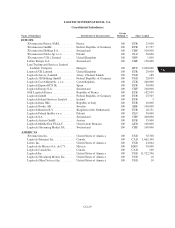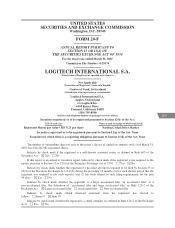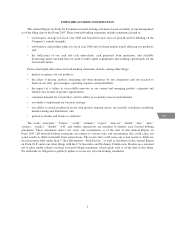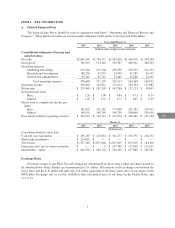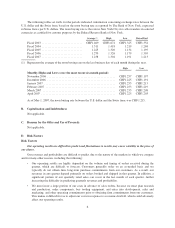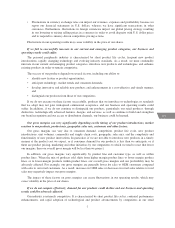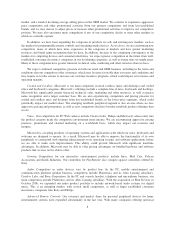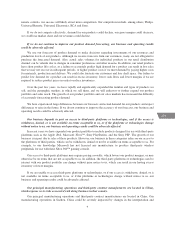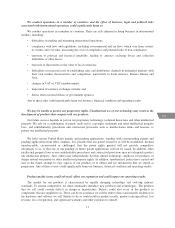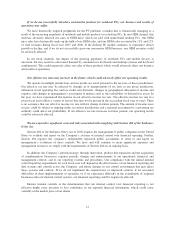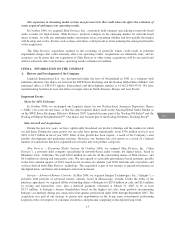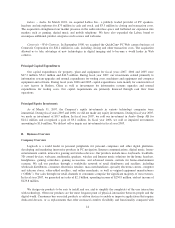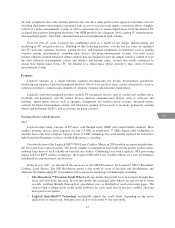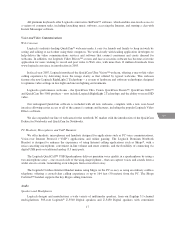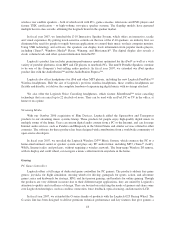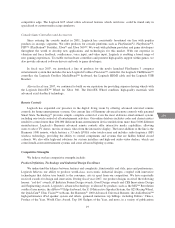Logitech 2007 Annual Report Download - page 61
Download and view the complete annual report
Please find page 61 of the 2007 Logitech annual report below. You can navigate through the pages in the report by either clicking on the pages listed below, or by using the keyword search tool below to find specific information within the annual report.
remote controls, our success will likely attract more competition. Our competitors include, among others, Philips,
Universal Remote, Universal Electronics, RCA and Sony.
If we do not compete effectively, demand for our products could decline, our gross margin could decrease,
we could lose market share and our revenues could decline.
If we do not continue to improve our product demand forecasting, our business and operating results
could be adversely affected.
We use our forecasts of product demand to make decisions regarding investments of our resources and
production levels of our products. Although we receive forecasts from our customers, many are not obligated to
purchase the forecasted demand. Also, actual sales volumes for individual products in our retail distribution
channel can be volatile due to changes in consumer preferences and other reasons. In addition, our retail products
have short product life cycles, so a failure to accurately predict high demand for a product can result in lost sales
that we may not recover in subsequent periods, or higher product costs if we meet demand by paying higher costs
for materials, production and delivery. We could also frustrate our customers and lose shelf space. Our failure to
predict low demand for a product can result in excess inventory, lower cash flows and lower margins if we are
required to reduce product prices in order to reduce inventories.
Over the past few years, we have rapidly and significantly expanded the number and types of products we
sell, and the geographic markets in which we sell them, and we will endeavor to further expand our product
portfolio and sales reach. The growth of our product portfolio and our sales markets has increased the difficulty
of accurately forecasting product demand.
We have experienced large differences between our forecasts and actual demand for our products and expect
differences to arise in the future. If we do not continue to improve the accuracy of our forecasts, our business and
operating results could be adversely affected.
Our business depends in part on access to third-party platforms or technologies, and if the access is
withdrawn, denied, or is not available on terms acceptable to us, or if the platforms or technologies change
without notice to us, our business and operating results could be adversely affected.
In recent years we have expanded our product portfolio to include products designed for use with third-party
platforms such as the Apple iPod, Microsoft Xbox™, Sony PlayStation, and the Sony PSP. The growth of our
business is in part due to sales of these products. However, our business in these categories relies on our access to
the platforms of third parties, which can be withdrawn, denied or not be available on terms acceptable to us. For
example, to our knowledge Microsoft has not licensed any manufacturer to produce third-party wireless
peripherals for use with their Xbox 360™ gaming console.
Our access to third-party platforms may require paying a royalty, which lowers our product margins, or may
otherwise be on terms that are not acceptable to us. In addition, the third-party platforms or technologies used to
interact with our product portfolio can change without prior notice to us, which can result in our having excess
inventory or lower margins.
If we are unable to access third-party platforms or technologies, or if our access is withdrawn, denied, or is
not available on terms acceptable to us, or if the platforms or technologies change without notice to us, our
business and operating results could be adversely affected.
Our principal manufacturing operations and third-party contract manufacturers are located in China,
which exposes us to risks associated with doing business in that country.
Our principal manufacturing operations and third-party contract manufacturers are located in China. Our
manufacturing operations in Suzhou, China could be severely impacted by changes in the interpretation and
9
CG


